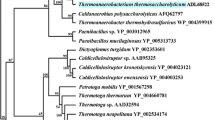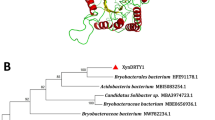Abstract
A thermostable xylanase gene, xyn10A (CAP0053), was cloned from Clostridium acetobutylicum ATCC 824. The nucleotide sequence of the C. acetobutylicum xyn10A gene encoded a 318-amino-acid, single-domain, family 10 xylanase, Xyn10A, with a molecular mass of 34 kDa. Xyn10A exhibited extremely high (92%) amino acid sequence identity with Xyn10B (CAP0116) of this strain and had 42% and 32% identity with the catalytic domains of Rhodothermus marinus xylanase I and Thermoascus aurantiacus xylanase I, respectively. Xyn10A enzyme was purified from recombinant Escherichia coli and was highly active toward oat-spelt and Birchwood xylan and slightly active toward carboxymethyl cellulose, arabinogalactouronic acid, and various p-nitrophenyl monosaccharides. Xyn10A hydrolyzed xylan and xylooligosaccharides larger than xylobiose to produce xylose. This enzyme was optimally active at 60°C and had an optimum pH of 5.0. This is one of a number of related activities encoded on the large plasmid in this strain.





Similar content being viewed by others
References
Ali BRS, Romaniec MM, Hazlewood GP, Freedman RB (1995) Characterization of the subunits in an apparently homogeneous subpopulation of Clostridium thermocellum cellulosomes. Enzyme Microb Technol 17:705–711
Ali MK, Fukumura M, Sakano K, Karita S, Kimura T, Sakka K, Ohmiya K (1999) Cloning, sequencing, and expression of the gene encoding the Clostridium stercorarium xylanase C in Escherichia coli. Biosci Biotechnol Biochem 63:1596–1604
Biely P (1985) Microbial xylanolytic systems. Trends Biotechnol 3:286–290
Biely P, Vrsanska M, Tenkanen M, Kluepfel D (1997) Endo-beta-1,4-xylanase families: differences in catalytic properties. J Biotechnol 57:151–166
Bradford MM (1997) A rapid and sensitive method for the quantitation of microgram quantities of protein utilizing the principal of dye binding. Anal Biochem 86:142–146
Coutinho PM, Henrissat B (1999) Carbohydrate-active enzymes: an integrated database approach. In: Recent advances in carbohydrate bioengineering. The Royal Society of Chemistry, Cambridge, pp 3–12
Derewenda U, Swenson L, Green R, Wei Y, Morosoli R, Shareck F, Kluepfel D, Derewenda ZS (1994) Crystal structure at 2.6-Å resolution, of the Streptomyces lividans xylanase A, a member of the F family of β-1,4,-D-glycanases. J Biol Chem 269:20811–20814
Grohmann K, Wymann CE, Himmel ME (1992) Potential for fuels from biomass and waste. In: Rowell RM, Schults TP, Narayan R (eds) Emerging technologies for materials and chemicals from biomass. American Chemical Society, Washington, D.C., pp 354–392
Henrissat B, Bairoch A (1960) Updating the sequence-based classification of glycosyl hydrolases. Biochem J 316:695–696
Herbers K, Wilke I, Sonnewald U (1995) A thermostable xylanase from Clostridium thermocellum expressed at high levels in the apoplast of transgenic tobacco has no detrimental effects and is easily purified. Bio/technology 13:63–66
Jones DT, Woods DR (1986) Acetone-butanol fermentation revisited. Microbiol Rev 50:484–524
Karlsson NE, Roxa EB, Holst O (1997) Cloning and sequence of a thermostable multidomain xylanase from the bacterium Rhodothermus marinus. Biochim Biophys Acta 1353:118–124
Karlsson NE, Dahlberg L, Torto L, Gorton L, Holst O (1998) Enzymatic specificity and hydrolysis pattern of the catalytic domain of the xylanase Xyn1 from Rhodothermus marinus. J Biotechnol 60:23–35
Katsube Y, Hata Y, Yamaguchi H (1990) Estimation of xylanase active site from crystalline structure. In: Ikehara M (ed) Protein engineering. Japan Scientific Societies, Tokyo, pp 91–96
Kellet LE, Pool DM, Ferreira LMA, Durrant AJ, Hazlewood GP, Gilbert HJ (1990) Xylanase B and an arabinofuranosidase from Pseudomonas fluorescens subsp. cellulosa contain identical cellulose binding domains and are encoded by adjacent genes. Biochem J 272:369–376
Kitamoto N, Yoshino S, Ito M, Kimura T, Ohmiya K, Tsukagoshi N (1998) Repression of the expression of genes encoding xylanolytic enzymes in Aspergillus oryzae by introduction of multiple copies of the xynF1 promoter. Appl Microbiol Biotechnol 50:558–563
Kosugi A, Murashima K, Doi RH (2002) Xylanase and acetyl esterase activities of XynA, a key subunit of the Clostridium cellulovorans cellulose for xylan degradation. Appl Environ Microbiol 68:6399–6402
Kulkarni N, Shendye A, Rao M (1999) Molecular and biotechnological aspects of xylanases. FEMS Microbiol Rev 23:411–456
Laemmli UK (1970) Cleavage of structural proteins during the assembly of the head of bacteriophage T4. Nature 227:680–685
Lee SF, Forsberg CW, Gibbins LN (1985) Xylanolytic activity of Clostridium acetobutylicum. Appl Environ Microbiol 50:1068–1076
Lee SF, Forsberg CW, Rattray M (1987) Purification and characterization of two endoxylanases from Clostridium acetobutylicum ATCC 824. Appl Environ Microbiol 53:644–650
Lo Leggio L, Kalogiannis S, Bhat MK, Pickersgill RW (1999) High resolution structure and sequence of T. aurantiacus xylanase I: implications for the evolution of thermostability in family 10 xylanases and enzymes with (beta) alpha-barrel architecture. Proteins 36:295–306
Lo Leggio L, Kalogiannis S, Eckert K, Teixeira SCM, Bhat MK, Andrei C, Pickersgill RW, Larsen S (2001) Substrate specificity and subunit mobility in T. aurantiacus Xylanase 10A. FEBS Lett 509:303–308
Miller GL (1959) Use of dinitrosalicylic acid reagent for determination of reducing sugar. Anal Chem 31:426–428
Morris JG (1993) History and future potential of Clostridia in biotechnology. In: Woods DR (ed) The Clostridia and biotechnology. Butterworth–Heinemann, Stoneham, pp 227–246
Nolling JG, Breton G, Omelchenko MV, Makarova KS, Zeng Q, Gibson R, Lee HM, Dubois J, Qiu D, Hitti J, Wolf YI, Tatusov RL, Sabathe F, Doucette-Stamm L, Soucaille P, Daly MJ, Bennett GN, Koonin EV, Smith DR (2001) Genome sequence and comparative analysis of the solvent producing bacterium Clostridium acetobutylicum. J Bacteriol 183:4823–4838
Ohmiya K, Sakka K, Karita S, Kimura T (1997) Structure of cellulases and their applications. Biotechnol Genet Eng Rev 14:365–414
Paradis FW, Zhu H, Krell PJ, Phillips JP, Forsberg CW (1993) The XynC gene from Fibrobacter succinogenes S85 codes for a xylanase with two similar catalytic domains. J Bacteriol 175:7666–7672
Rogers P (1986) Genetics and biochemistry of Clostridium relevant to development of fermentation process. Adv Appl Microbiol 31:1–60
Shimada K, Karita S, Sakka K, Ohmiya K (1994) Cellulases, xylanases, and their genes from bacteria. In: Murooka Y, Imanaka T (eds) Recombinant microbes for industrial and agricultural applications. Dekker, New York, pp 395–429
Sunna A, Antranikian G (1997) Xylanolytic enzymes from fungi and bacteria. Crit Rev Biotechnol 17:39–67
Teather RM, Wood PJ (1982) Use of Congo red–polysaccharide interactions in enumeration and characterization of cellulolytic bacteria from the bovine rumen. Appl Environ Microbiol 43:777–780
Tenkanen M, Siika-aho M, Hausalo T, Puls J, Viikari L (1996) Synergism of xylanolytic enzymes of Trichocoderma ressei in the degradation of acetyl-4-0-methylglucuronoxylan. In: Srebotnik E, Messner K (eds) Biotechnology in pulp and paper industry, recent advances in applied and fundamental research. WUV-Universitatsverlag, Vienna, pp 503–508
Timell TE (1967) Recent progress in the chemistry of wood hemicelluloses. Wood Sci Technol 1:45–70
Tomme P, Warren AJ, Miller RC Jr, Kilburn DG, Gilkes NR (1995) Cellulose-binding domains—classification and properties. In: Sadder JM, Penner M (eds) The enzyme degradation of insoluble polysaccharides. American Chemical Society, Washington, D.C., pp 142–162
Viikari L, Ranua M, Kantellinen A, Sundquist J, Linko M (1986) Bleaching and enzymes. Proc Int Conf Biotechnol Pulp Pap Ind 3:67–69
Watson MEE (1984) Compilation of published signal sequences. Nucleic Acids Res 13:5145–5164
Wong KKY, Saddler JN (1992) Trichoderme xylanases: their properties and application. In: Visser J, Beldman G, Spmeren MAK, Voragen AGJ (eds) Xylans and xylanases. Elsevier, Amsterdam, pp 171–186
Wood WA, Bhat KM (1988) Methods for measuring cellulase activities. Methods Enzymol 160:87–112
Zhu H, Paradis FW, Krell PJ, Phillips JP, Forsberg CW (1994) Enzymatic specificities and modes of action of the two catalytic domains of the XynC xylanase from Fibrobacter succinogenes S85. J Bacteriol 176:3885–3894
Acknowledgements
We thank Prof. Kazuo Sakka, Mie University, Japan, for supplying pQE-30T. This research was supported by the United States Department of Agriculture, Grant 00-35500-926, and the Robert A. Welch Foundation, grants C-1268 and C-1372.
Author information
Authors and Affiliations
Corresponding author
Rights and permissions
About this article
Cite this article
Ali, M.K., Rudolph, F.B. & Bennett, G.N. Characterization of thermostable Xyn10A enzyme from mesophilic Clostridium acetobutylicum ATCC 824. J IND MICROBIOL BIOTECHNOL 32, 12–18 (2005). https://doi.org/10.1007/s10295-004-0192-z
Received:
Accepted:
Published:
Issue Date:
DOI: https://doi.org/10.1007/s10295-004-0192-z




